E-Travel Log #7: Xiahe -- Tibetan Culture
Dear Students:
Tashi
dele! (Tibetan for 'Hello!) In this travel log, we'll trade in our camels
for yaks and climb from the Silk Road  up
onto the Qinghai-Tibetan Plateau. We won't go all the way to Tibet,
but we'll visit a town on the edge of the plateau nicknamed Little Tibet: Xiahe. There, we'll walk through the Labrang Monastery and visit
two Tibetan schools. We'll also tell you a story about a child hero called Si Ma Guang; tell you more about gushi; challenge you with two more
guess-who poems about Asian animals; and list some more answers to your
questions. Enjoy!
up
onto the Qinghai-Tibetan Plateau. We won't go all the way to Tibet,
but we'll visit a town on the edge of the plateau nicknamed Little Tibet: Xiahe. There, we'll walk through the Labrang Monastery and visit
two Tibetan schools. We'll also tell you a story about a child hero called Si Ma Guang; tell you more about gushi; challenge you with two more
guess-who poems about Asian animals; and list some more answers to your
questions. Enjoy!
ONE COUNTRY: MANY PEOPLES
China has the largest population in the world, an incredible 1.3 billion people. (That's well over four times the population of the U.S.) Of those, 92% are of the Han ethnic group. Officially, China has 55 other ethnic groups, referred to as minorities, mostly from the western provinces. Mandarin Chinese is the official language of China. Though minority peoples have their own mother tongues, they all learn Mandarin in school.
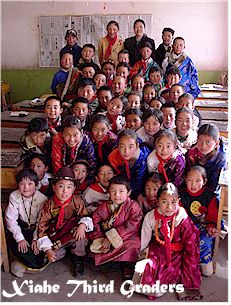 In
this report, you'll meet children from one of China's 55 minorities: Tibetan. Tibet is one of China's provinces - and the ancestral home of the
Tibetans. Many Tibetans, though, have moved from Tibet to other Chinese
provinces on the giant Qinghai-Tibetan Plateau. Xiahe, the town we
are visiting in this travel log, is in Gansu Province.
In
this report, you'll meet children from one of China's 55 minorities: Tibetan. Tibet is one of China's provinces - and the ancestral home of the
Tibetans. Many Tibetans, though, have moved from Tibet to other Chinese
provinces on the giant Qinghai-Tibetan Plateau. Xiahe, the town we
are visiting in this travel log, is in Gansu Province.
XIAHE: HOME OF THE LABRANG MONASTERY
Most Tibetans practice Buddhism, a religion founded by a man named Siddhartha Guatama over 2500 years ago. Buddhism developed in India, but traveled to China in the early centuries of the first millennia A.D. via the Silk Road. In time, Xiahe became a major center of Tibetan Buddhism and is now the home of the most important Tibetan Buddhist Monastery outside of Tibet: The Labrang Monastery.
Let's
pay a visit. 
The
Labrang Monastery is a holy place and a village rolled into one. The villagers
are 1,400 Buddhist monks (all boys and men). They live  in very simple
houses, but meditate and study in a giant complex of beautifully
decorated temples and buildings. Surrounding the monastery are long
halls containing thousands of prayer wheels. Every day, hundreds
of monks and people from the nearby town walk the two-mile circumference of the monastery, spinning each prayer wheel - a devotional act of prayer.
in very simple
houses, but meditate and study in a giant complex of beautifully
decorated temples and buildings. Surrounding the monastery are long
halls containing thousands of prayer wheels. Every day, hundreds
of monks and people from the nearby town walk the two-mile circumference of the monastery, spinning each prayer wheel - a devotional act of prayer.
MONKS AND NOMADS
The Labrang Monastery and Xiahe are surrounded by mountains. In between some of those mountains are wide grasslands. Many nomadic Tibetans live in tents on the grasslands and tend their herds of sheep and yaks. It shouldn't be surprising, then, that their main foods are lamb, yak milk products and yak meat - and that they make most of their clothing from wool - from both sheep and yaks. Yaks even provide fuel for fires - in the form of dung. While in Xiahe, we visited two Tibetan schools, one in town and one out on a grassland area called Sangke. The students created artwork and videos for their partner schools in the U.S.
At
Sangke, they wore their colorful traditional clothing and performed lively
traditional Tibetan songs and dances for us, sharing the richness of their culture.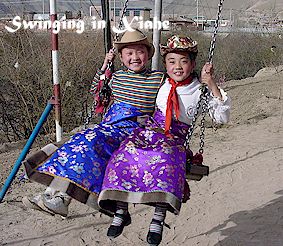
 CULTURE: THINGS THAT GO TO MAKE UP A LIFE
CULTURE: THINGS THAT GO TO MAKE UP A LIFE
Religion, food, clothing, forms of shelter, language, art, song and dance - these are all things that go to make up a culture: a way of living that is special and different from the way other people live, but one that is shared with a larger group. Because the world is so big, filled with people with many different languages, foods and lifestyles, it is also filled with many cultures. What things go to make up your culture?

SI MA GUANG USES HIS HEAD
Stories, of course, are an important part of culture, too. Here's a story that can be found in school textbooks across China, the story of how Si Ma Guang saved the day.
[Si Ma Guang was a famous scholar and politician during the Bei Song Dynasty (960-1127AD).]
When Si Ma Guang was a child, he loved to study and was very clever. One day when he was seven years old, he was playing with children in the neighborhood. They found an isolated garden and started to play hide-and-seek. There was a big water tank in the garden made of pottery and filled with rainwater. When the children were finding a place to hide, they suddenly heard screaming for help. They rushed back to where they started and found that a small child had climbed up the water tank and fell into it. The water tank was deep and the child couldn't swim. Slowly he began to drown and the other kids were not strong enough to pull him out of the water. Some of them started to cry and they ran back to get the adults for help. Si Ma Guang, on the other hand, wasn't crying at all. He thought hard for a second and suddenly had an idea. He found a big rock and used all his force to break the bottom of the water tank open. The water rushed out and, by the time the adults arrived, the child was already saved.
GUSHI
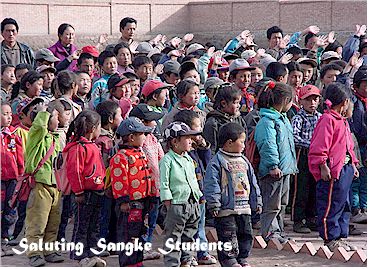 In
the other reports, we've been telling you a little bit about Chinese gushi
(ancient poems). Our guess-who animal poems are modeled after gushi, but
because Chinese and English are such different languages, they can't really
be true gushi. You see, the animal poems have the same syllable-patterns
as real gushi (four lines with five syllables each or four lines with seven
syllables each), but Chinese is a tonal language (with four different tones)
and real gushi, along with syllable-pattern repetition, use repeated sequences
of tones to create specific rhythms that cannot be copied in English.
In
the other reports, we've been telling you a little bit about Chinese gushi
(ancient poems). Our guess-who animal poems are modeled after gushi, but
because Chinese and English are such different languages, they can't really
be true gushi. You see, the animal poems have the same syllable-patterns
as real gushi (four lines with five syllables each or four lines with seven
syllables each), but Chinese is a tonal language (with four different tones)
and real gushi, along with syllable-pattern repetition, use repeated sequences
of tones to create specific rhythms that cannot be copied in English.
Also, five or seven syllables in Chinese can pack more meaning than five or seven syllables in English. Can you figure out why? We'll tell you in the next report.
GUESS WHO
Here are two more guess-who animal poems written in gushi form, one with five syllables per line and one with seven.
Guess who! Animal #1
Shaggy
fur becomes warm coat
Thick milk gets churned into cheese
Dung droppings are burned as fuel
A ride turned into a meal
 Animal
#2
Animal
#2
Four-legged pinecone
Long tails on both ends
Odd ball of armor
Chinese medicine
The answers to the poems in the last report are the panda bear and the caribou (or reindeer).
Q & A EXCHANGE
Here are more answers to your questions.
These questions were answered by (mostly fifth grade) students at the Jinha Elementary School in Jinha in the Xishuangbanna Rain Forest region of Yunnan Province.
1. What kinds of things do you do for fun? What games do you play? Do you play outside? What sports? We play running games and a game called 'Hawks Catching Chicks'. We read storybooks and watch TV during our free time. We play soccer, basketball and volleyball. We also love to jump ropes and jog.
2. What animals do you see in your area? Do you have pets? If so, what kind? What kinds of animals are in your rainforest? Are insects a problem? Is it rare to see a panda? We see birds, butterflies, pangolins, geckos, chickens, pigs, donkeys, geese, monkeys, snakes, dragonflies, ants and many fish. Some of us have pets like dogs, cats and parrots. Insects are not a problem. There are no pandas in the rain forest. They live in Sichuan Province where there is lots of bamboo.
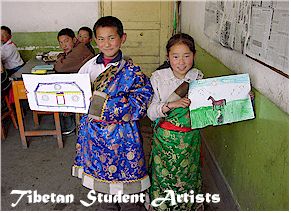 3.
What are your meals like? What are your favorite foods? Do you have American
restaurants there? We eat rice with some vegetables, meat or fish every
meal. Our favorite foods are potato chips, ice cream, pearl milk tea (flavored
milk tea with gelatinous rice balls), grapes, mango and bamboo worms. No,
we don't have American restaurants in our area.
3.
What are your meals like? What are your favorite foods? Do you have American
restaurants there? We eat rice with some vegetables, meat or fish every
meal. Our favorite foods are potato chips, ice cream, pearl milk tea (flavored
milk tea with gelatinous rice balls), grapes, mango and bamboo worms. No,
we don't have American restaurants in our area.
4. What's the name of your school? Where is it? What does your school look like? What subjects do you have in school? What are your favorite subjects? Are your teachers nice? Do you ever go on field trips? Where do you go? Our school is called Jinha xiang zhong xin xiao xue -- Jinha Central Elementary School. Our school has one two-story building and one three-story building, with a total of 25 classrooms. We also have dorm rooms where some students who live far away stay. We have a kitchen, where food is prepared for the boarding students. There's a garden and a statue between the two large buildings. We have a soccer field, a basketball court and a ping-pong area. There's also an area where teachers live. We study Chinese, Math, Natural Science, Social Studies, P.E., Music, Arts and Virtue. Our favorite subjects include Arts, Music and P.E. Our teachers are very nice and we like them. We go on field trips to a reservoir nearby or to the river where we can swim and play.
 5.
Do you have malls where you live? Where do you shop for clothes? Do you
make your own clothes? No, we don't have malls where we live, but we do
have markets where we can buy everything we need. Most of us can't make
clothes for ourselves but our mothers can.
5.
Do you have malls where you live? Where do you shop for clothes? Do you
make your own clothes? No, we don't have malls where we live, but we do
have markets where we can buy everything we need. Most of us can't make
clothes for ourselves but our mothers can.
6. Do you have to do chores at home? What are your responsibilities? Yes, we all have to do chores. We wash dishes, wash clothes, clean our houses, cook and take care of our younger siblings.
7. Do you ever travel to the rain forest? What do you do there? What do you see there? We live in the rain forest. Around our towns there are lots of mountains, rice fields, rubber trees and palm trees. We also see birds and butterflies. Some of us live deeper in the rain forest on the mountains, and there are more trees and animals there.
8. What are some of your names? And what do your names mean? [Note from Lilia: In Chinese, the sir names go first and a lot of times they don't mean anything, so I will just explain what the first names mean. But also note that Dai women's names often start with yu (Jade) and Dai men's names often start with Ai (Rock).] Some girls' names are Zhou Wen (Literature), Zhou Ling (Clever and Pretty), He Li Ming (Dawn), Yu Xiang Nuan (Jade Fragrant Warm), Lin Xin Yue (Heart Moon), Yu Shuang (Jade Double) and Yu Lan (Jade Orchid). Some boys' names are Ai Le (Rock Happy), Ai Long (Rock Dragon), Jiang Tao (Ocean Waves), Xiao Yu Xiong (Growing Hero), Ai Jiang (Shout) and Zhang Wen Lin (Knowledge Forest).
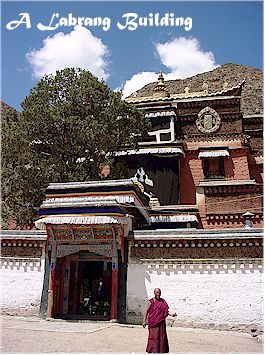 9.
Do you use electronics? Video Games? TV? DVD? Computers? Yes, we use
electronics. Boys like to play video games and we mostly have TVs at home.
The school has a TV, a computer and a DVD player.
9.
Do you use electronics? Video Games? TV? DVD? Computers? Yes, we use
electronics. Boys like to play video games and we mostly have TVs at home.
The school has a TV, a computer and a DVD player.
10. What musical instruments do you learn to play? What is the most unusual instrument in China? Some of us can play the piano, drum, keyboard and flute. In this region the most unusual instrument must be the gourd flute, which is like a short flute attached to the end of a gourd and you blow into the gourd to make music. It's very nice to listen to and it's a very traditional instrument.
THAT'S ALL FOR NOW
That's all for this travel log. In our next report, we'll hitch a ride on a fishing boat down the Mekong River to the Xishuangbanna Rain Forest region of China. There, we'll check out the forest and meet some students who live there. Till then, learn lots! Zai jian!
Lilia
and Paul
China School Project
<><><><<><><><><><><><><><><><><><><><><><><><><><><><><><><><><><><>
E-Travel
Log #7: Xiahe - Tibetan Culture |
